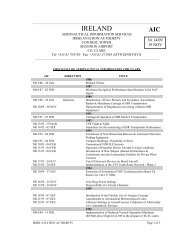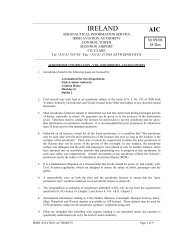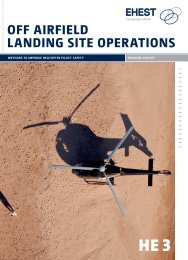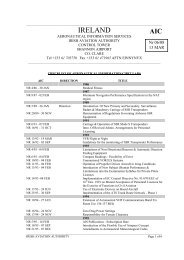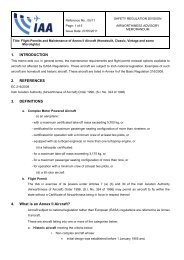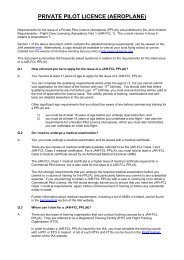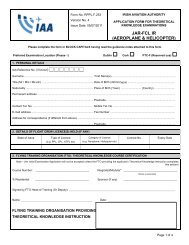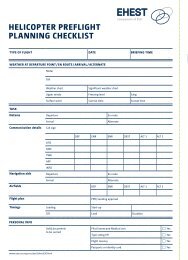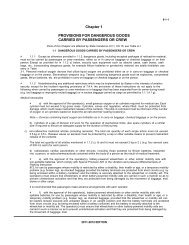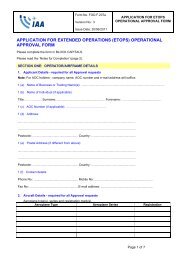8-1-1Chapter 1PROVISIONS FOR DANGEROUS GOODSCARRIED BY PASSENGERS OR CREWParts of this Chapter are affected <strong>by</strong> State Variations CH 1, US 15; see Table A-11.1 DANGEROUS GOODS CARRIED BY PASSENGERS OR CREW 1.1.1 Except as otherwise provided in 1.1.2, <strong>dangerous</strong> <strong>goods</strong>, including excepted packages of radioactive material, mustnot be <strong>carried</strong> <strong>by</strong> <strong>passengers</strong> or <strong>crew</strong> members, either as or in carry-on baggage or checked baggage or on their person.Except as provided <strong>for</strong> in Table 8-1, 30), security type equipment such as attaché cases, cash boxes, cash bags, etc.,incorporating <strong>dangerous</strong> <strong>goods</strong>, <strong>for</strong> example lithium batteries or pyrotechnic material, are totally <strong>for</strong>bidden; see entry inTable 3-1. Personal medical oxygen devices that utilize liquid oxygen are <strong>for</strong>bidden either as or in carry-on baggage or checkedbaggage or on the person. Electroshock weapons (e.g. tasers) containing <strong>dangerous</strong> <strong>goods</strong> such as explosives, compressedgases, lithium batteries, etc., are <strong>for</strong>bidden in carry-on baggage or checked baggage or on the person.1.1.2 Notwithst<strong>and</strong>ing any additional restrictions which may be implemented <strong>by</strong> States in the interests of aviation security,except <strong>for</strong> the incident reporting provisions of 7;4.4 or 7;4.5, as applicable, the provisions of these Instructions do not apply tothe following when <strong>carried</strong> <strong>by</strong> <strong>passengers</strong> or <strong>crew</strong> members or in baggage that has been separated from its owner during transit(e.g. lost baggage or improperly routed baggage) or in excess baggage <strong>carried</strong> as cargo as permitted <strong>by</strong> 1;1.1.5.1 g):1.1.3 Any organization or enterprise other than an operator (such as a travel agent), involved in the air transport of<strong>passengers</strong>, should provide <strong>passengers</strong> with in<strong>for</strong>mation about the types of <strong>dangerous</strong> <strong>goods</strong> which they are <strong>for</strong>bidden totransport aboard an aircraft. This in<strong>for</strong>mation should consist of, as a minimum, notices at those locations where there is aninterface with the <strong>passengers</strong>.1.1.4 Where provision is made <strong>for</strong> the purchase of tickets via the Internet, in<strong>for</strong>mation on the types of <strong>dangerous</strong> <strong>goods</strong>which a passenger is <strong>for</strong>bidden to transport aboard an aircraft should be provided in either text or pictorial <strong>for</strong>m <strong>and</strong> should besuch that ticket purchase cannot be completed until the passenger, or a person acting on their behalf, has indicated that theyhave understood the restrictions on <strong>dangerous</strong> <strong>goods</strong> in baggage.Table 8-1. <strong>Provisions</strong> <strong>for</strong> <strong>dangerous</strong> <strong>goods</strong> <strong>carried</strong> <strong>by</strong> <strong>passengers</strong> or <strong>crew</strong>Items or articlesMedical necessities1) Small gaseous oxygen or aircylinders required <strong>for</strong> medicaluseCheckedbaggageLocationCarry-onbaggageOn thepersonApproval of theoperator(s)is requiredThe pilot-incomm<strong>and</strong>mustbe in<strong>for</strong>medRestrictionsYes Yes Yes Yes Yes a) no more than 5 kg gross mass per cylinder;b) cylinders, valves <strong>and</strong> regulators, where fitted,must be protected from damage which couldcause inadvertent release of the contents; <strong>and</strong>c) the pilot-in-comm<strong>and</strong> must be in<strong>for</strong>med of thenumber of oxygen or air cylinders loaded onboard the aircraft <strong>and</strong> their loading location(s).Devices containing liquid oxygen No No No n/a n/a Devices containing liquid oxygen are <strong>for</strong>bidden incarry-on baggage, checked baggage or on theperson.2) Cylinders of a gas of Division 2.2worn <strong>for</strong> the operation ofmechanical limbsYes Yes Yes No No Spare cylinders of a similar size are also allowed, ifrequired, to ensure an adequate supply <strong>for</strong> theduration of the journey.2013-2014 EDITION
8-1-2 Part 8Items or articles3) Non-radioactive medicinalarticles (including aerosols)CheckedbaggageLocationCarry-onbaggageOn thepersonApproval of theoperator(s)is requiredThe pilot-incomm<strong>and</strong>mustbe in<strong>for</strong>medRestrictionsYes Yes Yes No No a) no more than 0.5 kg or 0.5 L total net quantityper single article;b) release valves on aerosols must be protected <strong>by</strong>a cap or other suitable means to preventinadvertent release of the contents; <strong>and</strong>4) Radioisotopic cardiacpacemakers or other devices,including those powered <strong>by</strong>lithium batteries implanted into apersonRadio-pharmaceuticalscontained within the body of aperson5) Mobility aids (e.g. wheelchairs)powered <strong>by</strong> non-spillable wetbatteries or batteries whichcomply with Special ProvisionA123, <strong>for</strong> use <strong>by</strong> <strong>passengers</strong>whose mobility is restricted <strong>by</strong>either a disability, their health orage, or a temporary mobilityproblem (e.g. broken leg)c) no more than 2 kg or 2 L total net quantity of allarticles mentioned in 3), 10) <strong>and</strong> 13) (e.g. fouraerosol cans of 500 mL each) per person.n/a n/a Yes No No Must be implanted into a person as the result ofmedical treatment.n/a n/a Yes No No Must be as the result of medical treatment.Yes No No Yes (see 5 d)iv))a) non-spillable wet batteries must comply withSpecial Provision A67 or the vibration <strong>and</strong>pressure differential tests of PackingInstruction 872;b) the operator must verify that:i) the battery is securely attached to themobility aid;ii)iii)the battery terminals are protected fromshort circuits (e.g. <strong>by</strong> being enclosed withina battery container); <strong>and</strong>electrical circuits have been isolated;c) mobility aids must be <strong>carried</strong> in a manner suchthat they are protected from being damaged <strong>by</strong>the movement of baggage, mail, stores or othercargo;d) where the mobility aid is specifically designed toallow its battery(ies) to be removed <strong>by</strong> the user(e.g. collapsible):i) the battery(ies) must be removed; themobility aid may then be <strong>carried</strong> as checkedbaggage without restriction;ii)iii)the removed battery(ies) must be <strong>carried</strong> instrong, rigid packagings which must bestowed in the cargo compartment;the battery(ies) must be protected fromshort circuit; <strong>and</strong>iv) the pilot-in-comm<strong>and</strong> must be in<strong>for</strong>med ofthe location of the packed battery;e) it is recommended that <strong>passengers</strong> makeadvance arrangements with each operator.2013-2014 EDITION



